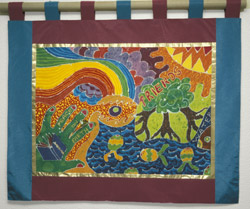Bannerama (1996-98)

What was the project?
As part of the European Textiles network Conference of 1996, held for the first time in Manchester, Start developed a partnership with the PumpHouse People’s History Museum, Manchester, to explore modern banners.
Why did we take the project on?
Project coordinator Wendy Teall says: “The PumpHouse contains the national collection of Trades Union banners. Its staff were keen to celebrate the banner’s continuing relevance as a cultural messenger by investigating personal, political and topical issues of the moment with our student group. At Start we were eager to create a body of work that would challenge both us and our students. We were also delighted to benefit from the resources offered by the PumpHouse. Their collection of banners is second to none, and the support they were able to access for the project from Manchester University’s Museum Studies Course was really invaluable.”
How did we go about making the work?
We began the project with an historical overview of the motivations behind the messages on the Trades Union banners. This helped us to define what our own concerns were, and how we would make our messages clear to our audience. Some students found that messages from the past still resonated with their own lives, and so they referenced their work to the slogans and symbols contained in historical banners. Others wanted to explore intensely personal issues of family, health, relationships, dreams or aspirations, struggles faced and battles won. Their messages had both a personal and a wider contemporary cultural appeal, creating a snapshot of a moment in social history for one group of people.
Final word
Bannerama, an exhibition of 38 banners made of materials as diverse as paper, wire, wood, ceramic, fibre and plastic, toured to gallery venues across the north west region for 2 years. It marked an important change in the way Start applied its training and education methods, as we began to enable our students to embrace designer-maker processes, to use their work to communicate social messages, and to embed their work in social comment about issues such as mental health.
